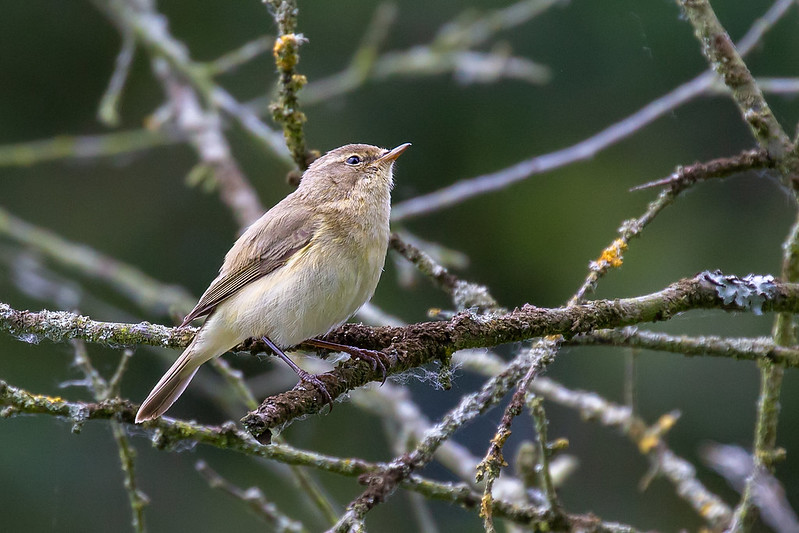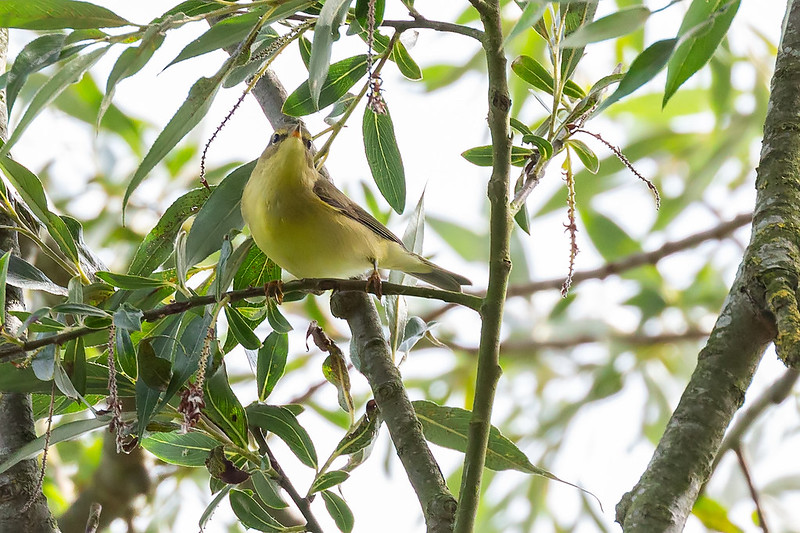- Home
- How to Identify Wild Birds
- Chiffchaff or Willow Warbler?
Is it A Chiffchaff or a Willow Warbler?
For the longest time, every one of these little olive-drab birds was just a "Chiff-low Warbler" to me.
I’d see a flash of olive-brown/green in the branches, my brain would scramble, and the bird would be gone before I could even begin to work it out.
It’s one of birdwatching’s classic challenges, and if you’ve ever felt that wave of identification panic, you are absolutely not the only one.
But learning to separate them is one of the most satisfying skills you can develop.
It’s the moment you move from just hearing them to truly seeing them. This guide is my personal approach to breaking down the problem, one clue at a time.
Always Start With the Song
Before we look at a single feather, let's listen. If the bird is singing, it will give you the answer 99% of the time. It's the most beginner-friendly and reliable way to know who's who.
- Chiffchaff: Sings its own name in a simple, rhythmic, two-note pattern: "chiff-chaff, chiff-chaff".
- Willow Warbler: Has a much more romantic, complex song. It’s a beautiful, silvery cascade of notes that gently tumbles down the scale. It sounds like a sigh of relief.
But what happens when they’re quietly feeding, especially during autumn migration when the singing has stopped? That's when we need to use our eyes.
The Visual Challenge
This is how I taught myself to look. I start with the most obvious clue and work my way down.
Check The Legs: The Most Reliable First Clue
This is the first thing I try to see. In good light, it’s often the clearest giveaway.
- Chiffchaff.: Has dark almost black legs.The stand out against a green leaf or pale branch.
- Willow Warbler:Typically has pale, brownish or pinkish-looking legs.
There can be exceptions with mud or strange light, but if you see pale legs, you can be pretty confident you're looking at a Willow Warbler.
Watch The 'Jizz': The Vibe of the Bird
'Jizz' is just a birder's term for the overall impression a bird gives—its posture, its movement, its personality. This is less about a single feature and more about the feeling it gives you.
- ChiffChaff (The Nervous Fidgeter): Is known for its constant, energetic tail-flicking. It's a sharp, downward pump that it does almost compulsively. It seems busy, compact, and a little tense.
- Willow Warbler (The Smooth Operator): Is much more placid. It rarely flicks its tail. It seems to glide through the branches with a smoother, more horizontal posture. It feels more delicate and elongated.
Look at The Face: The Subtle Confirmation
If you get a good, close view, the face provides another layer of evidence.
- Willow Warbler: Generally has a brighter, longer and more distinct yellowish 'eyebrow' (supercilium). This gives it a more defined and slighter 'friendlier' looking facial expression.
- Chiffchaff: Its eyebrow is usually shorter, duller and less distinct, giving it a plainer, less-contrasted look.
The Wings: An Expert-Level Detail
This is a more advanced feature, but it's great for confirming an ID. We're talking about "primary projection"—the length of the long flight feathers (the primaries) that stick out beyond the shorter wing feathers when the wing is folded.
- Willow Warbler: Is a long-distance migrant and has long wings. The primary projection is very noticeable, about the same length as the bird's bill.
- Chiffchaff: Is a shorter-distance migrant with shorter wings. The primary projection is much less obvious.
When I was learning to tell the difference experts would tell me about the longer primaries and I had no idea what they were talking about.
But don't get hung up on this one at first!
It’s something your eye will learn to see over time. Think of it as the final piece of the puzzle.
I was extremely lucky to be visiting Spurn Point when the wardens were ringing birds arriving at migration time. One of those that had been caught was a willow warbler and we got to see the difference in primaries close up.
Your Camera: The Ultimate Learning Tool
Sometimes the best way to learn these differences is away from the field.
Your camera can be your greatest ally here.
A quick photo—even one that isn't perfectly sharp—allows you to zoom in at home and examine the leg colour, face pattern, and wing structure without the pressure of the bird flying away.
It turns a fleeting, frustrating glimpse into a valuable, lasting lesson.

Common Chiffchaff — compact and alert, with plain olive-brown plumage and dark legs. Often found in bare branches early in the season.

Willow Warbler — slightly yellower and more delicate-looking, with pale legs and longer wings. Often seen in leafy canopies in spring.
Your Challenge: One Clue at a Time
Don't try to learn all this at once. For your next few walks, just focus on one thing.
- Week 1: Forget everything else and just try to see the leg colour of every warbler you spot.
- Week 2: Shift your focus to behaviour. Watch for that classic Chiffchaff tail-flick.
Breaking it down like this turns a frustrating task into a manageable and rewarding game.
Share your story
What did it feel like when you finally saw the difference clearly for the first time? Share your "it finally clicked!" moments here. I'd love to read them as I am sure would other visitors. Let's get the conversation started.
What Other Visitors Have Said
Click below to see contributions from other visitors to this page...
Do Willow Warblers Visit Gardens? Not rated yet
"I saw a warbler in my garden that looked like a Chiffchaff but had quite pale legs. Could it have been a Willow Warbler in my garden?"
Carol's response: …

About the Author
For me, it’s never been just about bird names or camera settings, but the thrill of seeing a distant speck turn into a hunting kestrel.
After years of learning how to notice and photograph those moments, my camera has become the tool - and this site the field notebook - where I share what I’ve discovered.
If you’re ready to look a little closer, you’ll find the trips, lessons, and small wins that can help you see and photograph the wildlife right on your doorstep.
Step Behind the Wild Lens
If you’ve enjoyed your time here, you can also follow along by email.
I send the Wild Lens newsletter occasionally. It’s where I share:
- Fresh field notes and recent encounters
- The stories behind favourite photos
- Practical tips that don’t always make it onto the site
You’ll get new UK wildlife guides, photo tips, and ideas for your next walk, straight to your inbox.